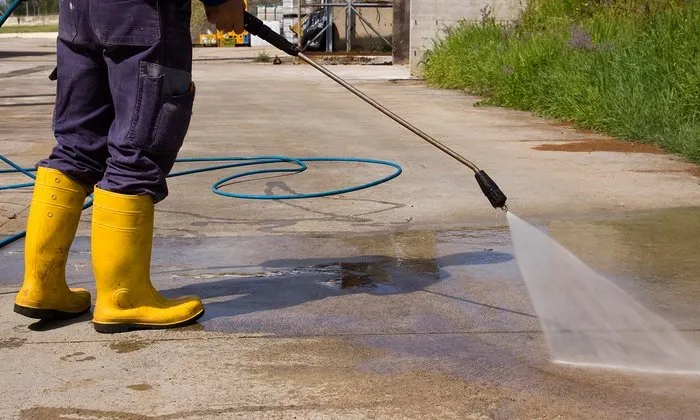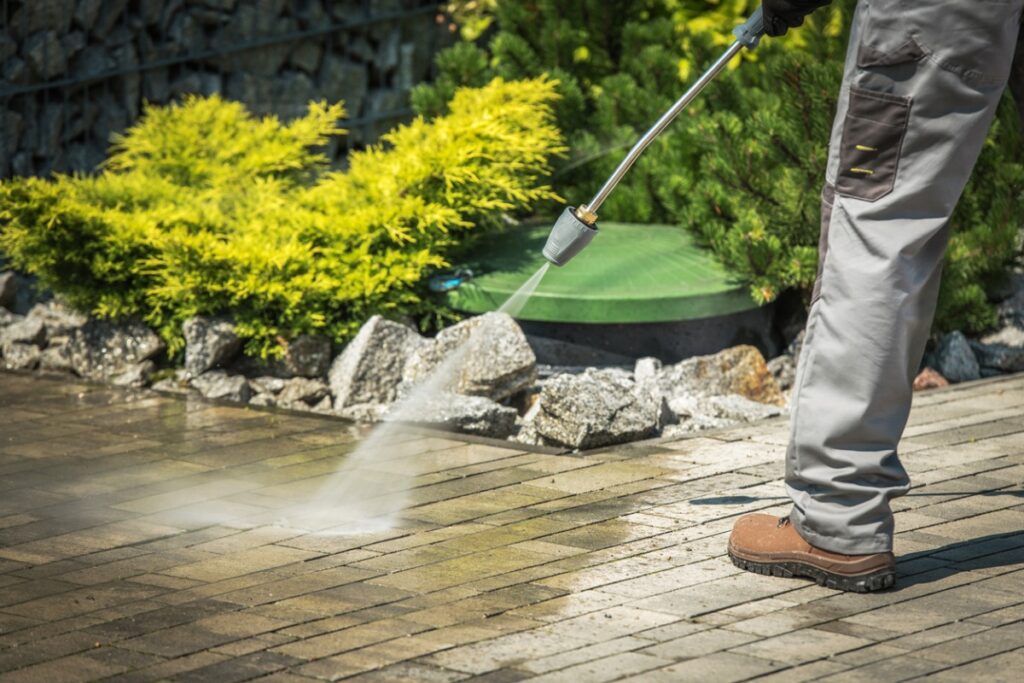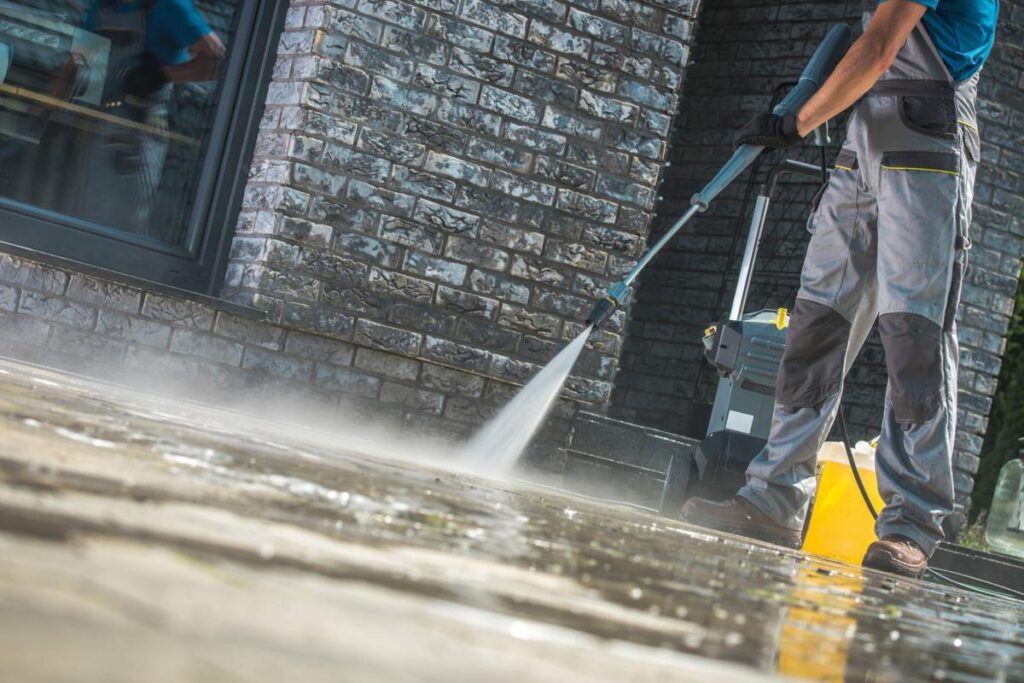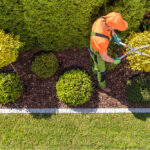Consider this article your trusted guide to mastering power washing. We’ll cover everything you need to know and more.
From how often to do it, to the common do’s and don’ts.
When your normal scrub and clean can’t tackle the mess outside, it’s time to power wash. Power washing is a quick and easy solution to revitalize your outdoor surfaces.
Why Power Wash
Nature reclaims all things. And unfortunately, you see this year after year on most of your surfaces outside.
Bright fences become faded with dust and grime that doesn’t seem to rinse away in the rain. Cement, patio pavers, and driveways become dull and develop algae growth.
Power washing puts an end to that green and swampy look.
Many people interchange the words power washing and pressure washing.
Others specify that power washers use heated water while pressure washers do not. Heated or not, power washing uses a high-pressure stream of water to remove debris.
Power washing preps surfaces for painting or applying sealant coatings. But it’s mainly used for deep cleaning.
Power washing is good for, but not limited to brick, stucco, stone, concrete, and wood surfaces.
Cleaning and restoring your hardscapes will help keep them looking their best for longer. You may need a landscape professional in Minnesota to ensure you’re getting the results you want.
Benefits of Power Washing
One thing is certain: power washing is superior to regular cleaning methods. We’ve broken down the top benefits of power washing:
Ease of Use
The best thing about power washing is that it does most of the work for you. It requires no hard scrubbing on your hands and knees.
The high-pressure stream of water can lift dirt that clings to outdoor surfaces.
And it does this in a matter of seconds. Other less-effective cleaning methods take so much more time and energy.
Cleaner Surfaces
No matter how much effort and water you put into cleaning your driveway or patio with a hose, power washing will do a much better job. There is no comparison in the results.
It’s like giving your outdoor surfaces a facelift. Even the grimiest fences, walls, and walks will look years newer.
Prevents Decay
The dirt, moss, rust, and debris left behind on outdoor surfaces can speed up the decaying process. Dirt buildup (with organic content) is a common cause of mold growth.
Over time, the debris left on surfaces will cause damage.
Power washing is the best way to keep your home’s exterior siding, hardscape, and even outdoor furniture looking its best and for many years.
Power Washing Is Eco-friendly
If you have ever cleaned an outdoor surface with a regular hose, then you know it’s very easy to waste water.
Power washers on the other hand use less water than a traditional hose when cleaning. In fact, a pressure washer will use 70-75% less water.
Power washing is also an eco-friendly option because you often don’t need to use chemicals or cleaning products. Yes, power washing with just plain water can make a big difference!
But using a cleaning product will help keep surfaces free of algae and mold longer. If a homeowner opts for cleaners, biodegradable and earth-safe options are available.
Home Value
Power washing enhances your curb appeal, beautifies your landscape, and improves your home’s value.
It’s essential if you’re planning to sell your house. Even if you don’t plan on selling, it’s still a great way to maintain a beautiful and appealing home.
How Often Should You Power Wash?
The best thing about power washing is that because it’s so effective, you don’t need to do it often. Most homeowners have their outdoor surfaces done once per year.
Power washing too often is unnecessary and only results in extra work. You aren’t doing yourself any favors by power washing a clean surface.
Common Do’s and Don’ts When Power Washing
Common do’s and don’ts include safety measures. It’s important to know how to handle a power washer before you try to use it.
So, we’ve broken down the most common do’s and don’ts, so you know what to do.
Let’s start with the “do’s”:
Ensure that all tubes and fittings are snug
You want to avoid any leakage to ensure you will be able to achieve the right amount of pressure.
Always wear safety glasses
This is essential for your protection. The high-pressure water can lead to dangerous flying debris.
Inspect the area to be power washed before beginning
Make sure there are no loose items that could be hazardous or easily damaged.
Now the “don’ts”:
Don’t power wash different sections all at once
Instead, progress through large surfaces by focusing on one section at a time. This ensures an even wash and the best outcome for you.
Don’t use the same nozzle for every job
There are a variety of nozzles that attach to your power washer hose. Each nozzle has a different spray pattern.
Narrow nozzles have more pressure. This means use a narrow one when you have a lot of caked-on grime. Use a larger nozzle when completing a job with less debris.
Don’t use your power washer before testing it
No, really. Don’t. Power washers have just that, power. If you haven’t used one before then use caution. Without experience, you may end up damaging everything you spray.
It’s best to test the washer in an inconspicuous area. This ensures you won’t ruin or etch the surface of something you look at all the time.
Why You Should Hire a Professional to Power Wash
In most cases, it’s best to go with a professional. They will know the right amount of pressure to use on the variety of materials found in your landscape.
Professionals have the expertise to do the job thoroughly but also safely.
Once you have experienced the benefits of professional power washing, you’ll have it done year after year. The results are too wonderful to miss.
Green Grounds Landscaping offers both commercial and residential power washing services.
Our team uses the best-in-class equipment to clean and restore the beauty of your exterior surfaces.
If you are interested in learning more about our landscape services, please contact us.











